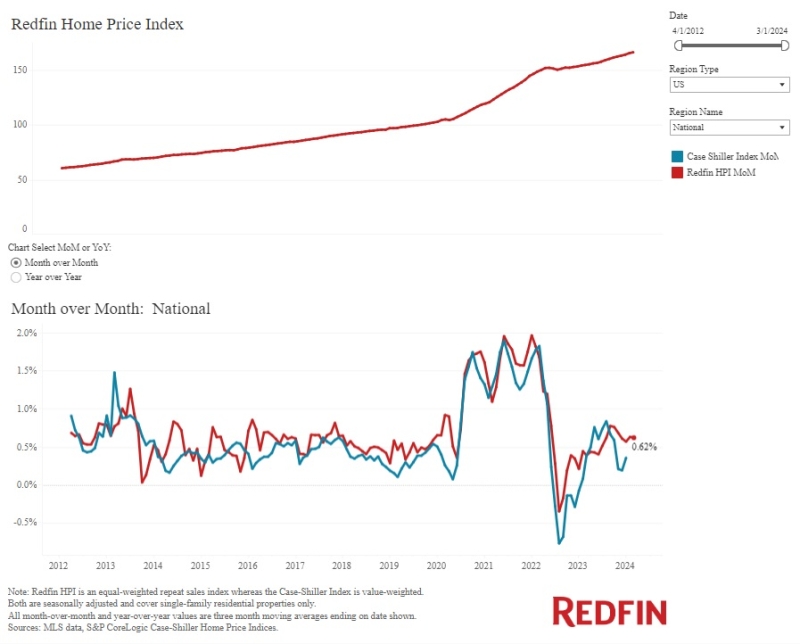Advertisement
Foreclosures Drop 10 Percent in February

RealtyTrac released its U.S. Foreclosure Market Report for February 2014, which shows foreclosure filings — default notices, scheduled auctions and bank repossessions — were reported on 112,498 U.S. properties in February, a 10 percent decrease from January and down 27 percent from February 2013 to the lowest monthly total since December 2006 — a more than seven-year low.
RealtyTrac also included updated information on the number of owner-vacated properties in the foreclosure process as part of the report. As of the first quarter of 2014, a total of 152,033 U.S. properties in the foreclosure process (excluding bank-owned properties) had been vacated by the distressed homeowner, representing 21 percent of all properties in the foreclosure process. These owner-vacated foreclosures — sometimes called zombie foreclosures — had been in the foreclosure process an average of 1,031 days.
“Cold weather and a short month certainly contributed to a seasonal drop in foreclosure activity in February, but the reality is that new activity is no longer the biggest threat to the housing market when it comes to foreclosures,” said Daren Blomquist, vice president at RealtyTrac. “The biggest threat from foreclosures going forward is properties that have been lingering in the foreclosure process for years, many of them vacant with neither the distressed homeowner or the foreclosing lender taking responsibility for maintenance and upkeep of the home — or at the very least facilitating a sale to a new homeowner more likely to perform needed upkeep and maintenance.
“One in every five homes in the foreclosure process nationwide have been vacated by the distressed homeowner, but it is closer to one in three foreclosures in some cities,” Blomquist added. “These properties drag down home values in the surrounding neighborhood and contribute to a climate of uncertainty and low inventory in local housing markets.”
High-level findings from the report:
►Owner-vacated foreclosures nationwide were flat compared to the last time RealtyTrac analyzed these properties, in the third quarter of 2013, but some states saw substantial increases, including Michigan (27 percent increase from September 2013), New Jersey (24 percent increase) and Nevada (21 percent increase).
►States with the most owner-vacated foreclosures were Florida with 54,908 (36 percent of the national total, Illinois (15,512), New York (10,880), New Jersey (8,595), and Ohio (7,780).
►States with the longest average time in foreclosure for owner-vacated foreclosures included Arkansas (1,128 days), Hawaii (1,112 days), Florida (1,095 days), Nevada (1,055 days), and New York (1,037 days).
►After a 10 percent month-over-month jump in January, U.S. foreclosure starts retreated to their lowest level since December 2005 — a 98-month low. A total of 51,842 U.S. properties started the foreclosure process for the first time in February, down 9 percent from the previous month and down 27 percent from a year ago.
►Counter to the national trend, February foreclosure starts increased from a year ago in 14 states, including New Jersey where foreclosure starts increased 126 percent from a year ago, boosting the state’s foreclosure rate to fourth highest in the nation — its highest foreclosure rate ranking since October 2005.
►A total of 47,715 U.S. properties were scheduled for a future foreclosure auction (in some states this is the foreclosure start) in February, down 15 percent from the previous month and down 21 percent from a year ago.
►Counter to the national trend, scheduled foreclosure auctions increased from a year ago in 19 states, including Oregon (up 389 percent), Utah (up 145 percent), Connecticut (up 141 percent), New Jersey (up 70 percent), and Maryland (up 36 percent).
►There were a total of 30,307 U.S. bank repossessions (REO) in February, up less than 1 percent from January but still down 33 percent from February 2013.
►Counter to the national trend, 15 states reported year-over-year increases in bank repossessions in February, including Connecticut (up 162 percent), New York (up 108 percent), Maryland (up 98 percent), New Jersey (up 90 percent), and Oregon (up 70 percent).
►States with the highest foreclosure rates in February were Florida, Maryland, Nevada, New Jersey and Illinois.
►Nine of the top 10 metro foreclosure rates in February were posted by cities in Florida, along with Atlantic City, N.J., where overall foreclosure activity increased 254 percent from a year ago.
►Among the nation’s 20 most populated metro areas, the highest foreclosure rates were in Tampa, Miami, Baltimore, Riverside-San Bernardino in Southern California, and Chicago. Only four of the 20 largest metro areas posted annual increases in foreclosure activity: New York (up 77 percent), Philadelphia (up 20 percent), Washington, D.C. (up 19 percent), and Baltimore (up 14 percent).
Florida, Maryland, Nevada post top state foreclosure rates
After jumping 19 percent on a month-over-month basis in January Florida foreclosure activity dropped seven percent from January to February and was down 24 percent on a year-over-year basis — the seventh consecutive month with an annual decrease. Despite the decrease, Florida still posted the nation’s top foreclosure rate, with one in every 372 housing units with a foreclosure filing during the month — more than three times the national average.
Florida foreclosure starts decreased annually for the 12th consecutive month, and Florida bank repossessions decreased annually for the sixth consecutive month. Scheduled foreclosure auctions in Florida decreased 2 percent annually in February after 13 consecutive months of annual increases.
Maryland foreclosure activity increased annually for the 20th consecutive month in February, helping it post the nation’s second highest state foreclosure rate — one in every 557 housing units with a foreclosure filing. On a year-over-year basis, Maryland foreclosure starts increased 15 percent, scheduled foreclosure auctions increased 36 percent, and bank repossessions increased 98 percent.
Nevada foreclosure activity in February decreased 16 percent from January and was down 49 percent from February 2013, but the state still posted the nation’s third highest foreclosure rate — one in every 633 housing units with a foreclosure filing.
New Jersey foreclosure activity increased 108 percent annually in February, and the state posted the nation’s fourth highest state foreclosure rate — one in every 739 housing units with a foreclosure filing. The No. 4 ranking was the highest ranking for New Jersey since October 2005.
Illinois foreclosure activity decreased 48 percent annually in February — the 15th consecutive month with an annual decrease — but the state still posted the nation’s fifth highest foreclosure rate: one in every 811 housing units with a foreclosure filing.
Other states with foreclosure rates among the nation’s 10 highest in February were Connecticut (one in every 898 housing units with a foreclosure filing), Ohio (one in every 941 housing units), South Carolina (one in every 971 housing units), Georgia (one in every 1,011 housing units), and Wisconsin (one in every 1,011 housing units).
Metro foreclosure rates and activity
Nine of the top 10 foreclosure rates in February among metropolitan statistical areas with a population of 200,000 or more were in Florida, led by Palm Bay-Melbourne-Titusville with one in every 296 housing units with a foreclosure filing during the month — nearly four times the national average.
Other Florida metros in the top 10 were Tampa at number two (one in every 318 housing units with a foreclosure filing); Jacksonville at number three (one in every 319 housing units); Miami at number four (one in every 328 housing units); Port St. Lucie at number five (one in every 361 housing units); Orlando at number six (one in every 370 housing units); Ocala at number eight (one in every 404 housing units); Tallahassee at number nine (one in every 407 housing units); and Lakeland (one in every 410 housing units).
Foreclosure activity in Atlantic City, N.J., increased 254 percent on a year-over-year basis — the third consecutive month with a triple-digit percentage annual increase — and the city posted the nation’s seventh highest metro foreclosure rate: one in every 398 housing units with a foreclosure filing during the month.
About the author





